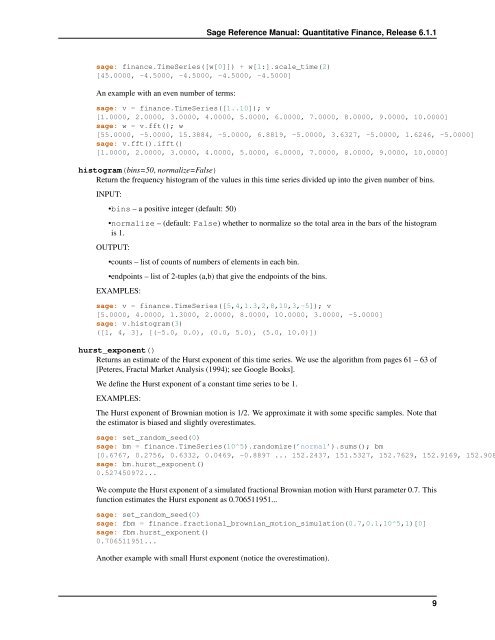Sage Reference Manual: Quantitative Finance - Mirrors
Sage Reference Manual: Quantitative Finance - Mirrors
Sage Reference Manual: Quantitative Finance - Mirrors
Create successful ePaper yourself
Turn your PDF publications into a flip-book with our unique Google optimized e-Paper software.
<strong>Sage</strong> <strong>Reference</strong> <strong>Manual</strong>: <strong>Quantitative</strong> <strong>Finance</strong>, Release 6.1.1<br />
sage: finance.TimeSeries([w[0]]) + w[1:].scale_time(2)<br />
[45.0000, -4.5000, -4.5000, -4.5000, -4.5000]<br />
An example with an even number of terms:<br />
sage: v = finance.TimeSeries([1..10]); v<br />
[1.0000, 2.0000, 3.0000, 4.0000, 5.0000, 6.0000, 7.0000, 8.0000, 9.0000, 10.0000]<br />
sage: w = v.fft(); w<br />
[55.0000, -5.0000, 15.3884, -5.0000, 6.8819, -5.0000, 3.6327, -5.0000, 1.6246, -5.0000]<br />
sage: v.fft().ifft()<br />
[1.0000, 2.0000, 3.0000, 4.0000, 5.0000, 6.0000, 7.0000, 8.0000, 9.0000, 10.0000]<br />
histogram(bins=50, normalize=False)<br />
Return the frequency histogram of the values in this time series divided up into the given number of bins.<br />
INPUT:<br />
•bins – a positive integer (default: 50)<br />
•normalize – (default: False) whether to normalize so the total area in the bars of the histogram<br />
is 1.<br />
OUTPUT:<br />
•counts – list of counts of numbers of elements in each bin.<br />
•endpoints – list of 2-tuples (a,b) that give the endpoints of the bins.<br />
EXAMPLES:<br />
sage: v = finance.TimeSeries([5,4,1.3,2,8,10,3,-5]); v<br />
[5.0000, 4.0000, 1.3000, 2.0000, 8.0000, 10.0000, 3.0000, -5.0000]<br />
sage: v.histogram(3)<br />
([1, 4, 3], [(-5.0, 0.0), (0.0, 5.0), (5.0, 10.0)])<br />
hurst_exponent()<br />
Returns an estimate of the Hurst exponent of this time series. We use the algorithm from pages 61 – 63 of<br />
[Peteres, Fractal Market Analysis (1994); see Google Books].<br />
We define the Hurst exponent of a constant time series to be 1.<br />
EXAMPLES:<br />
The Hurst exponent of Brownian motion is 1/2. We approximate it with some specific samples. Note that<br />
the estimator is biased and slightly overestimates.<br />
sage: set_random_seed(0)<br />
sage: bm = finance.TimeSeries(10^5).randomize(’normal’).sums(); bm<br />
[0.6767, 0.2756, 0.6332, 0.0469, -0.8897 ... 152.2437, 151.5327, 152.7629, 152.9169, 152.908<br />
sage: bm.hurst_exponent()<br />
0.527450972...<br />
We compute the Hurst exponent of a simulated fractional Brownian motion with Hurst parameter 0.7. This<br />
function estimates the Hurst exponent as 0.706511951...<br />
sage: set_random_seed(0)<br />
sage: fbm = finance.fractional_brownian_motion_simulation(0.7,0.1,10^5,1)[0]<br />
sage: fbm.hurst_exponent()<br />
0.706511951...<br />
Another example with small Hurst exponent (notice the overestimation).<br />
9

















